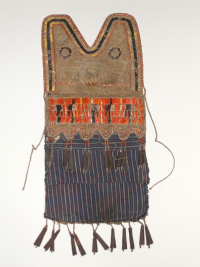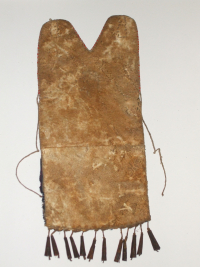bag, shoulder
bag, shoulder
bag, shoulder
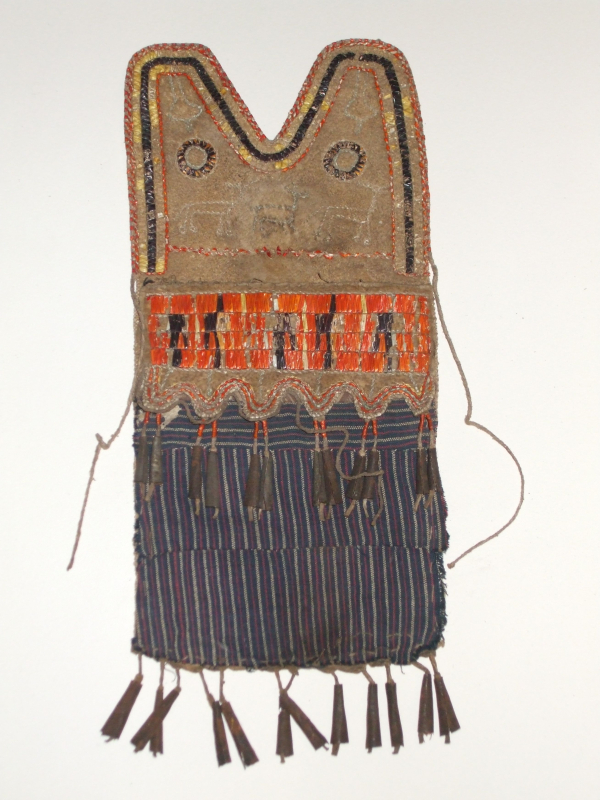
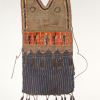
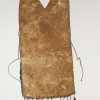
A shoulder bag made of hide and fabric, decorated with quillwork and metal tinkle cones cones. Three animals (dodems) are embroidered on the front part, along with what may be two eagles, and thunderbirds below. The front portion of the bag covered in cloth was originally wild duck skin, remnants of which remain in the seams. Collected by G.C. Beltrami in Wisconsin in 1823.
Museum documentation.
Read More About This Relative
animal hide; skin, wild duck; commercial cotton; metal cones; fabric, commercial cotton; sinew; commercial cotton yarn; porcupine quills, natural and dyed red, yellow, black and blue.
Made of animal hide with a fabric panel on the lower portion of the front. The upper section is decorated with porcupine quillwork. The middle section, directly below the opening of the bag, has a band of quillwork and a undulating lower edge, with each lobe decorated with two quill-wrapped tassels terminating in tinkle cones. The lower section is covered with three pieces of cloth, sewn together, with a quill-wrapped leather thong fringe at the bottom, ending in tinkle cones.
According to the Beltrami Collection catalogue author, Leonardo Vigorelli, "Il fronte della borsa, originariamente costituito da pelle di anatra selvatica, di cui rimangono frammenti nelle cuciture, reca ora in sostituzione un inserto di tessuto di cotone commerciale cucito con tendine." (p. 62) [The front of the bag, originally consisting of skin wild duck, of which fragments remain in the seams, has been replaced by an insert of commercial cotton fabric, from curtains.]
deer?; thunderbird; circles
Vigorelli in the Beltrami Collection catalogue states:" Il fronte della borsa, originariamente costituito da pelle di anatra selvatica, di cui rimangono frammenti nelle cuciture, reca ora in sostituzione un inserto di tessuto di cotone commerciale cucito con tendine." (p. 62)
Provenance
Collected by G.C. Beltrami from Wisconsin in 1823. Beltrami's collection catalogue states that around 1856, Beltrami's nephew donated several objects to the Civic Library of Bergamo, which were later transferred to the Museo Civico di Scienze Naturali.
The Beltrami Collection was exhibited in Florence in 1929 during the "Prima Esposizione Nazionale di Storia delle Scienze" (First National Exposition of History of Sciences"). In 1973, during a celebration of the Beltrami exhibit, Glauco Luchetti donated three objects from his own collection, which were located in Beltrami's last house in Filottrano, to the "Museo Civico E. Caffi". In 1987 the collection was used in the exhibit entitled "Missisippi 1823. Oggetti indiani raccolti da G. Costantino Beltrami" in the Galleria Lorenzelli in Bergamo.
The Beltrami Collection catalogue. Vigorelli, Gli Oggetti indiani raccolti da G.Costantino Beltrami (p.62).
Leonardo Vigorelli, Gli Oggetti indiani raccolti da G.Costantino Beltrami, Civico Museo E. Caffi, Bergamo, 1987.
About This GRASAC Record
This record was created by Emanuela Rossi after a trip funded by GRASAC to the Museo Civico E. Caffi in Bergamo, Italy in October 2008.
Researcher present: Emanuela Rossi.













In the Beltrami Collection Catalogue, the author, Leonardo Vigorelli, defines "Upper Mississippi" the Cultural Area of Origin. He defines "Northeast" as the Geographic Area.
 Knowledge Sharing Platform
Knowledge Sharing Platform

